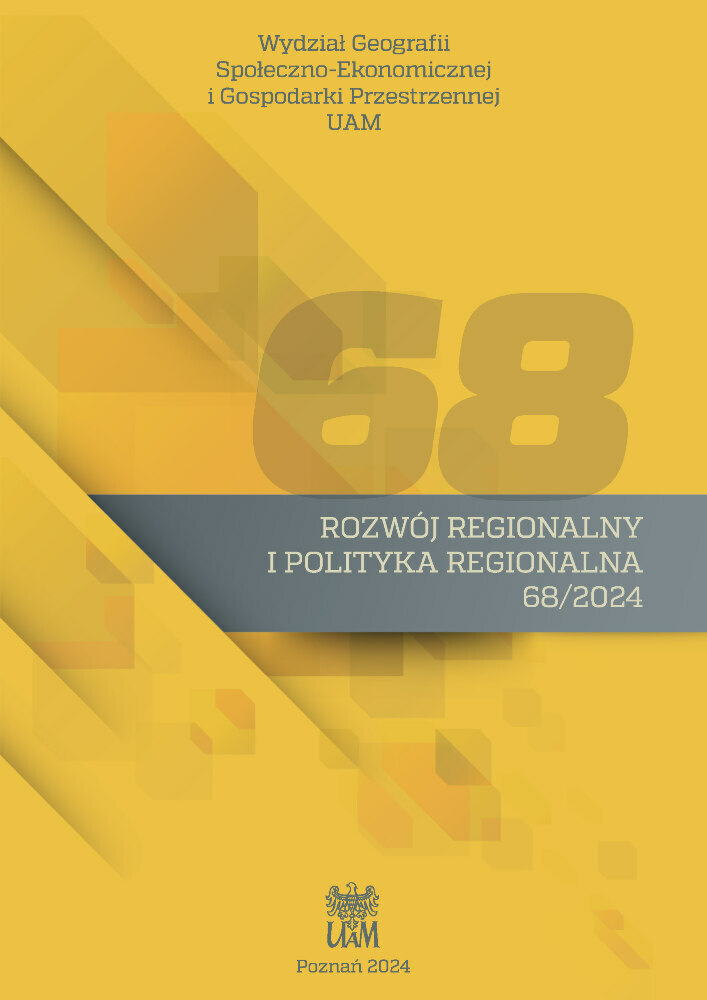Abstract
The purpose of the article is to show the consistency of revitalisation strategies (determined by revitalisation programs) with the existing crisis situations in municipalities (diagnosed in the programs), which will be served by, first, defining the crisis situations, and second, identifying recovery strategies in different types of municipalities (rural and urban-rural). The research method used was content analysis and comparative analysis. It was assumed that the characteristics of the municipality determine the way in which the municipal government operates, and thus contributes to the selection of a specific strategy according to which revitalisation is carried out. The analysis was made of municipalities selected intentionally – they differ in terms of their employment structure and the type of social structure that goes with it, defined by a specific arrangement of socio-professional groups.
15 revitalisation programs were analyzed – already this small number of studied cases allowed to indicate some regularities in the choice of revitalisation path. On the basis of the analysis, a disturbingly large number of similarities were noted in terms of the analyzed elements of revitalisation programs. It turned out that the nature of the entity does not determine the choice of the path for conducting the revitalisation process. The documents included unified diagnoses and revitalisation projects. In addition, a number of weaknesses were identified in the construction of the documents, which can negatively affect the effectiveness of their implementation.
References
Bachtler J., Gorzelak G. 2007. Regionalne strategie innowacji w Polsce. Studia Regionalne i Lokalne, 1(27): 309-326.
Dziedzic U., Trojanowski A. 2022. Brak zakładanych efektów w gminach. Przygotowanie i wdrażanie rewitalizacji. Kontrola Państwowa, 2.
Dziemianowicz W., Szmigiel-Rawska K., Nowicka P., Dąbrowska A. 2012. Planowanie strategiczne. Poradnik dla pracowników administracji publicznej. Ministerstwo Rozwoju Regionalnego, Warszawa.
Dziennik Urzędowy UE 2007. Traktat z Lizbony zmieniający Traktat o Unii Europejskiej i Traktat ustanawiający Wspólnotę Europejską (2007/C 306/01) (dostęp: 11.10.2022).
Gorlach K., Adamski T. 2007. Neo-Endogenous Development and the Revalidation of Local Knowledge. Polish Sociological Review, 160(4): 481-498.
Górz B., Gil A., Semczuk M. 2018. Szanse i ograniczenia w realizacji programów rewitalizacji obszarów wiejskich województwa małopolskiego. Przedsiębiorczość-Edukacja, 14: 93-108. DOI: https://doi.org/10.24917/20833296.14.7
GUS 2018. Dane statystyczne z zakresu rewitalizacji na poziomie gmin. GUS, Warszawa.
Halamska M. 2018. Studia nad strukturą społeczną wiejskiej Polski. T. 3. Wyd. Nauk. Scholar, IRWiR PAN, Warszawa.
Halamska M., Hoffman R., Stanny M. 2017. Studia nad strukturą społeczną wiejskiej Polski. T. 2. Wyd. Nauk. Scholar, IRWiR PAN, Warszawa.
Halamska M., Michalska S., Śpiewak R. 2010. LEADER w Polsce. Drogi implementacji programu. Wieś i Rolnictwo, 4: 104-119.
Jørgensen A., Fallov M., Nielsen R. 2021. ‘Just ask Eric’: On the Importance of Governance Efficacy, Territorial Ties and Heterogenous Networks for Rural Development. Sociologia Ruralis, 61: 303-321. DOI: https://doi.org/10.1111/soru.12328
Kisiała W., Bajerski A., Stepinski B. 2015. Realizacja regionalnych programów operacyjnych: analiza profili absorpcji funduszy unijnych w układzie centrum-peryferie. Studia Oeconomica Posnaniensia, 3(8): 113-130.
Knieć W. 2012. Wspólna Polityka Rolna a zrównoważony rozwój obszarów wiejskich Polski. Wyd. Nauk. UMK, Toruń.
Kovach I., Kucerova E. 2006. The Project Class in Central Europe: the Czech and Hungarian Cases. Sociologia Ruralis, 46: 3-21. DOI: https://doi.org/10.1111/j.1467-9523.2006.00403.x
Lacquement Q., Chevalier P. 2016. Capital territorial et développement des territoires locaux, enjeux théoriques et méthodogiques de la transposition d’un koncept de l’économie territoriale à l’analyse geographique. Annales de Géografie, 5: 490-518. DOI: https://doi.org/10.3917/ag.711.0490
Marks-Bielska R., Lizińska W., Babuchowska K., Wojarska M. 2017. Raport z wykonania projektu badawczego „Sprawność instytucjonalna vs. lokalny rozwój gospodarczy – czynniki kształtujące i interakcje”. Uniwersytet Warmińsko-Mazurski w Olsztynie, Olsztyn.
Ministerstwo Rozwoju 2016. Wytyczne w zakresie rewitalizacji w programach operacyjnych na lata 2014-2020. MR/H 2014-2020/20(2)08/2016.
Mróz A., Komorowski Ł., Wolański M., Stawicki M., Kozłowska P., Stanny M. 2022. The impact of territorial capital on Cohesion Policy in rural Polish areas. Regional Studies. DOI: https://doi.org/10.1080/00343404.2022.2091774
Novosák J., Hájek O., Horváth P., Nekolová J. 2017. Structural funding and intrastate regional disparities in post-communist countries. Transylvanian Review of Administrative Sciences, 51: 53-69. DOI: https://doi.org/10.24193/tras.51E.4
Rodríguez-Pose A. 2017. The revenge of the places that don’t matter (and what to do about it). Cambridge Journal of Regions, Economy and Society, 11(1): 189-209. DOI: https://doi.org/10.1093/cjres/rsx024
Sawicka Z. 2014. Małopolskie plany odnowy miejscowości jako instrument odnowy dziedzictwa przyrodniczego wsi. Zagadnienie Ekonomiki Rolnej, 1: 59-69.
Spasowska-Czarny H. 2017. Efektywność administracji publicznej w kontekście sprawności instytucjonalnej państwa. Annales Universitatis Mariae Curie-Skłodowska, 64: 179-187. DOI: https://doi.org/10.17951/g.2017.64.2.179
Stanny M., Rosner A., Komorowski Ł. 2018. Monitoring rozwoju obszarów wiejskich. Etap III. Fundacja Europejski Fundusz Rozwoju Wsi Polskiej, IRWIR PAN, Warszawa.
Stanny M., Rosner A. 2016. Monitoring rozwoju obszarów wiejskich. Etap II. Fundacja Europejski Fundusz Rozwoju Wsi Polskiej, IRWIR PAN, Warszawa.
Stanny M., Rosner A. 2014. Monitoring rozwoju obszarów wiejskich. Etap I. Przestrzenne zróżnicowanie poziomu rozwoju społeczno-gospodarczego obszarów wiejskich w 2010 roku. Fundacja Europejski Fundusz Rozwoju Wsi Polskiej, IRWIR PAN, Warszawa. DOI: https://doi.org/10.53098/9788393880614
Strategia Europa 2020. Strategia na rzecz inteligentnego i zrównoważonego rozwoju sprzyjającego włączeniu społecznemu 2010. Komisja Europejska, Bruksela.
Weber G. 2009. Versuch einer praxisnahen Ordnung empfohlener Bodenschutzinstru-mente. [W:] E. Hepperle, H. Lenk (red.), Land Development Strategies: Patterns, Risks and Responsibilities; Strategien der Raumentwicklung: Strukturen, Risiken und Verant-wortung. vdf Hochschulverlag ETH Zürich, Zürich, s. 143-156.
Weckroth M., Moisio S. 2020. Territorial Cohesion of What and Why? The Challenge of Spatial Justice for EU’s Cohesion Policy. Social Inclusion, 8: 183-193. DOI: https://doi.org/10.17645/si.v8i4.3241
Wilczyński R. 2016. Sytuacja rozwojowa wsi w woj. opolskim w warunkach depopulacji. Studia Obszarów Wiejskich, 41: 193-211. DOI: https://doi.org/10.7163/SOW.41.14
Yansui L., Yuheng L. 2017. Revitalize the world’s countryside. Nature, 548: 275-277. DOI: https://doi.org/10.1038/548275a
License
Copyright (c) 2024 Agata Mróz, Beata Paczek, Dominika Zwęglińska-Gałecka

This work is licensed under a Creative Commons Attribution 4.0 International License.

